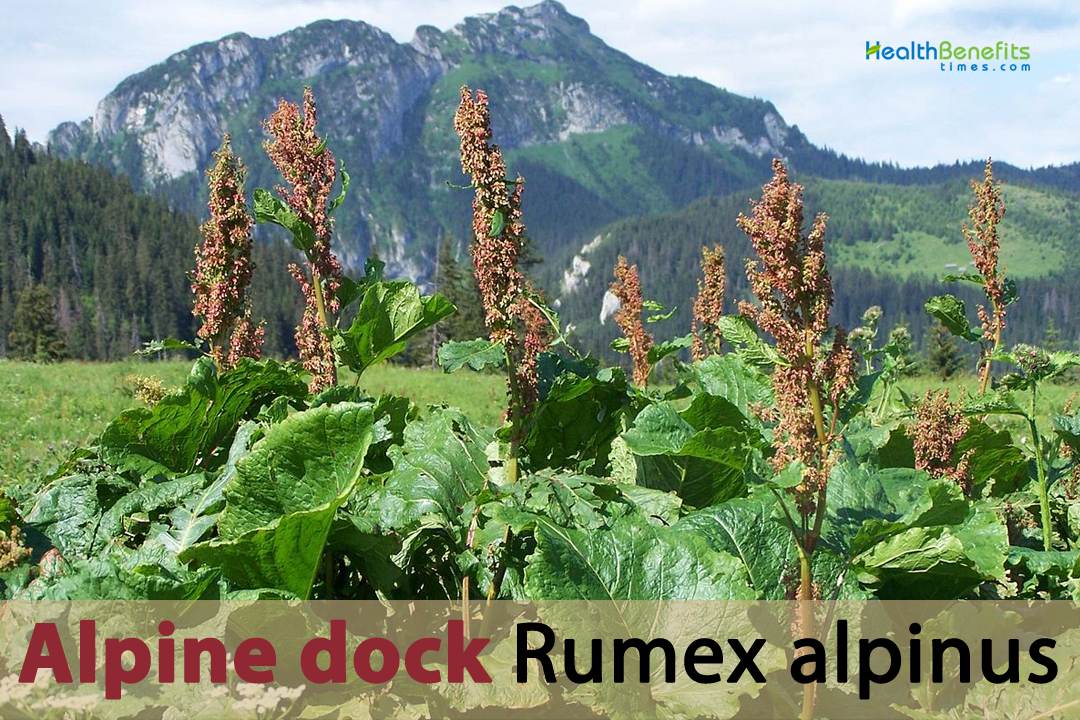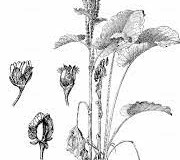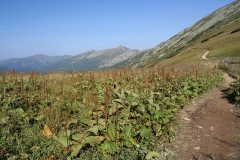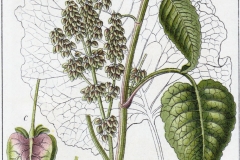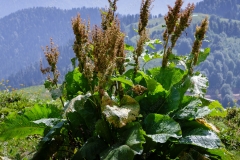The name “Rumex” comes from the Latin word “ruma,” which means “a lump or swelling.” It is thought to be about the swollen joints or nodes that are common in some species of the Rumex genus, such as Alpine dock. The name “alpinus” for the species comes from the Latin word “alpinus,” which means “of the Alps.” It shows that Rumex alpinus grows in mountainous areas like the Alps and is associated with alpine places. The plant is taken from the wild and used as food, medicine, and a source of materials by the people who live there. It has sometimes been grown for its leaves, which can be eaten, and it has also been grown for therapeutic purposes.
Alpine Dock Facts
| Alpine dock Quick Facts | |
|---|---|
| Name: | Alpine dock |
| Scientific Name: | Rumex alpinus |
| Origin | Alpine and subalpine regions of Europe and Asia |
| Colors | Initially green turning to dark brown to black in color |
| Shapes | Small brown, three-sided achenes that does not split open upon maturity |
| Taste | Tangy, acidic, and slightly lemon-like |
| Health benefits | Anti-inflammatory properties, Antioxidant activity, Digestive health, Liver support, Diuretic effects, Nutritional valu, Antimicrobial properties, Cardiovascular support, Respiratory ailments, Wound healing, Anti-diabetic potential |
| Name | Alpine dock |
|---|---|
| Scientific Name | Rumex alpinus |
| Native | Alpine and subalpine regions of Europe and Asia. It is found in mountainous areas, including the Alps, Carpathians, Pyrenees, Caucasus, Siberia, Mongolia, and northern China |
| Common Names | Alpine dock, Alpine sorrel, Mountain dock, Alpine wild rhubarb, Alpine knotweed, Alpine field sorrel, Field dock, Alpine sour dock, Mountain sorrel, Alpine sour grass, Alpine sour leaf, Alpine dock weed, Alpine patience dock, Alpine dock leaves |
| Name in Other Languages | Afrikaans: Alpen-dock Albanian: Lëpjetë, lëpjetë e Alpeve Arabic: Akidar jabaliun (أكيدار جبلي), Akidār jabali Aragonese: Napazuala Armenian: Aveluk alpiakan (Ավելուկ ալպիական) Bengali: Ālpāina ḍŏka (আল্পাইন ডক) Bulgarian: Alpiĭski lapad (алпийски лапад) Catalan: Paradella alpine, Rapòntic, Roma, Ruibarbre de frare Chinese: Gāoshān suān mó (高山酸模) Croatian: Alpska kiselica Czech: Rovnera, Šťovík alpský Danish: Alperibskov, Alpeskræppe, Munkerabarber Dutch: Alpen-hatweyblad, Alpenzuring English: Alpine dock, Alpine sorrel, Mountain dock, Alpine wild rhubarb, Alpine knotweed, Alpine field sorrel, Field dock, Alpine sour dock, Mountain sorrel, Alpine sourgrass, Alpine sourleaf, Alpine dockweed, Alpine patience dock, Alpine dockleaves, Butter Dock, Monk’s-Rhubarb, Mountain-Rhubarb, Munk’s Rhubarb, Munk’s Rhubarb Estonian: Harilik mägihapuoblikas Finnish: Pohjankiinankukka, Alppiraparperi, Alppihierakka French: Oseille des Alpes, L’oseille de montagne, Patience des Alpes, Rumex des Alpes, Rhapontie des moines, Rhubarbe des moines, Patience alpine, faux rhapontic, lampe, rhapontic commun, rhapontic des moines, rhapontic des montagnes, rhapontin, rhubarbe des Alpes, rhubarbe des montagnes, German: Alpen-ampfer, Giersch-Knöterich, Sauerampfer, Alpen vogelampfer, Alpen-ziest, Alpen-ampferblatt, Hochgebirgs-ampfer, Alpiner Sauerampfer, Alpen-Sauerampfer, Alpen-Sauerampferblatt, Alpen-Wiesenampfer, Alpen-Wiesen-Sauerampfer, Montafoner Sauerampfer, Alpen-Knöterich, Alpen-Rumex, Alpen-Rumexblatt, Alpen-Rumexwurzel, Mönchsrhabarber, Bergrhabarber, Blacke, Mönchsrhabarber Greek: Alpikí rapsódia (Αλπική ραψόδια), Roúmex o alpikós (Ρούμεξ ο αλπικός) Gujarati: Ālpāina ḍŏka (આલ્પાઇન ડોક) Hindi: Elpāin ḍŏk (एल्पाइन डॉक) Hungarian: Pápravirágos sóska, Alpesi paraj, havasi lórom Indonesian: Rumput asam pegunungan Italian: Alpen-riparia, Rumice alpino, Lavàzzi, Rabarbaro alpino, Romice alpino, Lavazza alpine, Lavazzi, Lavazzina alpina Japanese: Arupusu soba (アルプスソバ) Kannada: Ālpain ḍāk (ಆಲ್ಪೈನ್ ಡಾಕ್) Korean: yeongsan-ui geomeoli (영산의 거머리) , Gosan auk (고산아욱) Latin: Rumex alpinus Latvian: Kantonvärske Malay: Pokok sasalpin Malayalam: Ālpain ḍōkkŭ (ആൽപൈൻ ഡോക്ക്) Marathi: Ālpāin ḍŏk (आल्पाइन डॉक) Norwegian: Alpeknapp, Alpehøymol, Alpehøymole Occitan: llapasse Persian: ترشک آلپ Polish: Docka alpejska, Szczaw alpejski Portuguese: Serralha alpine Punjabi: Ēlpāin ḍauka (ਏਲਪਾਈਨ ਡੌਕ) Romanian: Loboda alpină Russian: Gornaya shchavel’ (Горная щавель), Al’piyskaya kislitsa (Альпийская кислица), Shchavel al’piyskiy (Щавел альпийский) Serbian: Alpski štavelj Slovak: Stiavec alpský, šťavel alpínsky, Slovene: Alpska kislica Spanish: Ruibarbo alpino, Acedera alpina , Rapóntico, Ruibarbo bastardo, Ruibarbo de los monjes, Ruibarbo imperial, Ruipóntico, Ruipóntico común, Ruipóntico de los indígenas, Ruipóntico indígena, romaza alpina Swahili: Denge la milima Swedish: Havängsdocka , Alpvallmo, Alppihierakka, Alpskräppa, Alpsyra, Tamil: Ālpain ṭāk (ஆல்பைன் டாக்) Telugu: Alpain ḍāk (అల్పైన్ డాక్) Thai: Xạl phịn̒d̆ xk (อัลไพน์ด็อก), Anphain d̂ĕk Turkish: Alp pazısı, şortah, Dağ labadası Ukrainian: Shchavelʹ alʹpiysʹkyy (щавель альпійський) Upper Sorbian: Alpski zdźer Urdu: Alpāin ḍāk Vietnamese: Cỏ xôi dãy núi Welsh: Rhiwbob y Mynach, Tafolen y Mynach |
| Plant Growth Habit | Rhizomatous, herbaceous, permanent plant |
| Growing Climates | Mountain and alpine meadows, riverbanks, marshes, moist forest edges, banks of streams, roadsides, yards, wooded slopes, gardens, behind cow-sheds, coppices, arable land, fields, rubbish dumps and in areas where domestic animals have stayed longer |
| Soil | Prefers moist to wet soil conditions. It grows best in well-draining soils that retain moisture but do not become waterlogged. The soil should be rich in organic matter and have a slightly acidic to neutral pH range of 6.0 to 7.5. If your soil is heavy or compacted, you can improve its drainage and fertility by adding organic matter such as compost |
| Plant Size | 60 to 200 centimeters (24 to 79 in) |
| Root | Roots of Alpine dock consist of a network of branching structures that extend from the base of the plant underground. They are typically fibrous and slender, branching out in various directions |
| Stem | Stem is herbaceous, typically green in color and is cylindrical in shape and can grow erect or slightly bending, reaching heights of up to 1 meter (3 feet) or more |
| Leaf | Leaves are generally elongated and lanceolate or oblong in shape, with a pointed tip and a tapered base. The leaf margins can be smooth or slightly wavy. Leaves are arranged alternately along the stem. |
| Flowering season | Between May and June |
| Flower | Small and are arranged in dense clusters known as panicles. Each individual flower consists of five greenish-yellow or greenish-red perianth segments. The perianth segments are not true petals but are modified sepals. They are usually triangular or heart-shaped and have a papery texture. The flowers are radially symmetrical |
| Fruit Shape & Size | Fruits are small brown, three-sided achenes that does not split open upon maturity |
| Fruit Color | Initially green turning to dark brown to black in color |
| Seed | Typically small and have an oval or oblong shape. They can vary in color, ranging from light brown to dark brown or black |
| Flavor/Aroma | Refreshing and invigorating blend of mountain air, wildflowers, evergreen trees, and earthy undertones |
| Taste | Tangy, acidic, and slightly lemon-like |
| Plant Parts Used | Leaves, roots, Rhizomes |
| Propagation | By seeds, Division, stem cuttings |
| Lifespan | Ranging from 5 to 15 years or even longer |
| Season | Between July and August |
| Varieties |
|
| Health benefits |
|
| Culinary Uses |
|
| Other Facts |
|
Plant Description
Alpine dock is a rhizomatous, herbaceous, permanent plant that grows from a thick, creeping, rhizomatous rootstock. It can be anywhere from 24 to 79 inches tall. It grows from 30 to 200 cm tall and has one to several straight stems with many branches on top. The plant grows in mountain and alpine meadows, riverbanks, marshes, moist forest edges, stream banks, roadsides, yards, wooded slopes, gardens, behind cow-sheds, coppices, arable land, fields, garbage dumps, and places where domestic animals have stayed longer. The plant does best in dirt that is moist to wet. It grows best in soils that drain well and hold rainwater but don’t get too wet. The pH of the earth should be between 6.0 and 7.5. It should also have a lot of organic matter. If your soil is heavy or packed down, adding organic matter like compost can help it drain better and be more fertile.
Appropriate growing environment for Alpine dock
Alpine dock is naturally adapted to alpine and subalpine regions, and it thrives in specific growing conditions. Here are some important factors to consider when creating an appropriate growing environment for Alpine dock:
- Climate: Alpine dock likes to live in places that are cool and have temperatures that range from cold to warm. It can handle winters that are cold and summers that are cool. It works well in alpine or subalpine areas, which have low average temperatures, high elevations, and long periods of snow cover.
- Sunlight: Alpine dock usually likes a little bit of shade better than full sun. In its native environment, it grows in open meadows or along the edges of forests, where it gets different amounts of sunlight at different times of the day. Ideal is a spot that gets straight sunlight for at least 4–6 hours a day.
- Soil: Alpine dock likes soil that is damp to wet. It does best in well-drained soils that keep water but don’t get too wet. The pH of the earth should be between 6.0 and 7.5. It should also have a lot of organic matter.
- Moisture: Alpine dock needs the right amount of water to grow and thrive. It likes soil that stays moist, but it can handle short times of flooding. If you want to grow Alpine dock in a garden, keep the soil evenly moist all through the growth season.
- Altitude: Alpine dock, as its name suggests, is able to live in high altitudes. From 1,500 to 3,000 meters (4,900 to 9,800 feet) above sea level, it can be found growing. Creating an environment for Alpine dock that is similar to higher elevations by giving it cooler temps and good growing conditions can help.
- Microclimate: Alpine dock might do better if you make a microclimate in your yard. This can be done by putting the plant in a safe place, like next to a wall or under the canopy of bigger plants. These things can help keep Alpine dock safe from bad weather and give it some shade on hot summer days.
Root
The roots of Alpine dock are made up of a network of structures that branch out from the base of the plant. They are usually thin and fibrous, and they grow in many different ways. The roots’ main job is to take in water and important nutrients from the dirt. They have tiny root hairs that make a lot more surface area for absorption. This makes it easy for the plant to get water and nutrients.
Stem
Stem is plant, which means it is not made of wood and can bend. It is usually green, but some kinds have a reddish tint. The stem is in the shape of a cylinder and can grow straight or slightly curved, reaching heights of 1 meter or more. Fine hairs called trichomes cover the stem, giving it a rough or slightly hairy feel. These hairs, called trichomes, can be more or less dense on different stems.
The main parts of the stem are the epidermis, the cortex, the vascular tubes, and the pith. These cells help support the plant, move water and nutrients, and store food and water for the plant. The stem is an important part of the plant because it holds up the whole plant, helps move water, nutrients, and carbs, and gives the plant a place to make flowers and fruits.
Bark
The plant doesn’t have a clear top layer like a tree would. Instead of bark, the stem has a layer called the epidermis on the outside that covers the tissues inside. As we’ve already said, this top layer may have fine hairs or trichomes, which give the stem a slightly rough or hairy feel.
Leaves
Leaves are simple, which means that they don’t have lobes. Most of the time, they are long and lanceolate or oblong, with a pointy tip and a narrow base. The edges of the leaves can be smooth or a little bit wavy. Along the stem, the leaves are grouped in pairs. This means that each leaf is connected to the stem at a different place. As you move up the stem, the sides of the leaves change. The veins on the leaves are pinnate, and the main veins run along the midrib. From the main vein, smaller minor veins branch out towards the edges of the leaf.
The leaves can be different sizes, but most of the time they are about the same size. They are usually between 5 and 15 centimeters (about 2 to 6 inches) long and between 1 and 5 centimeters (0.4 to 2 inches) wide. Most of the time, the upper surface of the leaves is smooth, while the lower surface, which has tiny hairs called trichomes, may feel a little rough. Some leaves have more hairs than others, and the number of hairs on each leaf can change. The leaves can be different shades of green, from bright green to darker green. The undersides of the leaves of some types may be reddish or purple. The leaves are thin and leafy, which means they are soft and bendable. They are not stiff or thick like the leaves of woody plants, which are. The tips of the leaves can be smooth or have a little wave to them, but they don’t have any big teeth or serrations. This makes the leaves look more or less smooth.
Flower
The panicles are long, branching clusters of flowers made up of many separate flowers. The panicles can grow up to 15 centimeters (6 inches) in length. Most of the time, the flowers are close to each other, making the cluster look full. The flowers are small and clumped together in groups called panicles. Each flower has five perianth parts that are greenish yellow or greenish red. The parts of the perianth that look like petals are actually changed sepals. Most of the time, they are triangle or heart-shaped and feel like paper. The flowers are the same on all sides.
It usually blooms from late spring to early summer, but the exact time can change based on where it is and what the weather is like. Most of the pollination of the flowers is done by the wind (anemophily). The plant doesn’t have pretty blooms or nectar, so it depends on the wind to move pollen from the stamens to the stigmas of other flowers, which are ready to accept it. This change makes pollination work well over a large area.
Fruits
The names of the fruits are achenes. Achenes are a dry fruit with one seed that doesn’t split open when it’s ready. They are very small and have a hard shell. Most of the time, the achenes are dark brown to black in color. They are in the shape of a triangle with sharp corners, like a small seed. The achene has a smooth, shiny skin on the outside. After the flowers are pollinated, the achenes grow from them. Each flower has the ability to make one achene. The achene grows inside the perianth, which is the flower’s changed sepal. As the fruit ages, the pieces of the perianth may dry out and fall off, exposing the achene.
Seeds
The seeds are inside the achenes. Each achene has a single seed inside. The seed is the plant’s reproductive structure and is how the plant grows more of itself. The seeds of most plants are small and oval or oblong in shape. They can be any color from light brown to black or dark brown. The outside of the seed is smooth and may even look shiny. Under the right conditions, the seeds can live for many years.
Varieties of Alpine dock
Alpine dock itself does not have recognized botanical varieties; there are variations of the species referred to as subspecies or ecotypes. Here are some known subspecies/ecotypes of Rumex alpinus:
- Rumex alpinus subsp. alpinus: This is the normal subspecies of Rumex alpinus that lives in alpine and subalpine areas of Europe and Asia. It has greenish-yellow or greenish-red perianths and leaves in the shape of a triangle or a heart.
- Rumex alpinus subsp. groenlandicus: This subspecies lives in Arctic places like Greenland. It grows more closely together than the usual subspecies, and its leaves and flower stalks are smaller.
- Rumex alpinus subsp. valesiacus: This subspecies lives in the Swiss Alps, in the Valais area. Compared to other types, it is known for having bigger leaves and stronger growth.
Health benefits of Alpine dock
Alpine dock has been used for centuries in traditional medicine due to its various health benefits. Here are some of the potential health benefits of Alpine dock:
1. Anti-inflammatory properties
Alpine dock has bioactive substances in it, like anthraquinones and flavonoids, which have been shown to reduce inflammation. These compounds might help lower inflammation in the body, which could help ease the symptoms of conditions like arthritis, gout, and inflammatory bowel disease that cause inflammation.
2. Antioxidant activity
The plant has a lot of antioxidants in it, like vitamin C, vitamin E, and different flavonoids. Antioxidants help the body get rid of dangerous free radicals, which lowers oxidative stress and keeps cells from getting hurt. By getting rid of free radicals, Alpine dock may be good for your health and well-being as a whole.
3. Digestive health
Alpine dock has been used for a long time to help the digestive system. It has chemicals in it called tannins, which have astringent properties and can help tighten and tone the tissues in the digestive system. This could help people who have diarrhea, dysentery, or other problems with their intestines.
4. Liver support
Traditional medicine has found that Alpine dock is good for protecting the liver. Some studies have shown that the plant may help protect the liver from damage caused by chemicals and oxidative stress. It may also help the liver work better and help the body get rid of toxins.
5. Diuretic effects
In ancient medicine, alpine dock was used to make people pee more. It is thought to increase the amount of pee made and help the body get rid of extra fluids and toxins. This traditional use suggests that it might help with things like water retention and problems with the urinary system.
6. Nutritional value
Alpine dock is high in fiber, vitamins, and minerals. It is full of nutrients like vitamin C, vitamin K, potassium, calcium, and magnesium. Adding Alpine dock to your diet can help you get more nutrients and help your body do different things.
7. Antimicrobial properties
Some studies show that Alpine dock may have antimicrobial qualities that could stop certain bacteria and fungi from growing. This trait may help fight infections and boost the immune system as a whole.
8. Cardiovascular support
Some studies show that Alpine dock might be good for your heart. It may help control blood pressure and cholesterol, which is good for the health of the heart. But more research is needed to find out how big these benefits are.
9. Respiratory ailments
Alpine dock has been used for a long time to treat breathing problems like coughs, pneumonia, and asthma. It is thought to have qualities that help loosen phlegm and get rid of congestion, which makes it easier to breathe.
10. Wound healing
Alpine dock leaves have been used as a poultice or ointment to help bruises, cuts, burns, and other skin irritations heal. Its astringent and antimicrobial qualities may help clean and protect the affected area, which may speed up the healing process.
11. Anti-diabetic potential
Early research suggests that Alpine dock may have anti-diabetic properties that could help reduce blood sugar levels. But more study is needed to confirm these effects and learn more about them.
Culinary Uses
The unique ways to cook with alpine dock are not well known or written down. Even though similar species in the Rumex genus, like common sorrel and French sorrel, have long been used in cooking, Alpine dock may not be as useful or may have fewer uses. However, based on the characteristics and flavors associated with sorrel varieties, including Alpine dock, here are some general culinary uses and considerations:
- Salads: Alpine dock leaves can be used in salads if they are safe to eat. Their tangy and slightly sour taste can make a mixed green salad taste different. Alpine dock leaves are refreshing and tart when mixed with other salad greens, herbs, and veggies.
- Soups and Sauces: Alpine dock leaves can be used to add a tart and sour taste to soups and sauces. Add the leaves near the end of cooking to keep their flavorful freshness. They can be added to veggie soups, soups with cream, or sauces to make them brighter.
- Herbal Vinegars: By putting the leaves of alpine dock in vinegar, you can make tangy and tasty herbal vinegar. Just put the leaves in a bottle of vinegar and let them sit there for a few weeks. The vinegar that is made can be used in salad sauces, marinades, or as a sour condiment.
- Herbal Butters: Mix Alpine dock leaves into butter that has been warmed to make flavored compound butter. Mix leaves that have been finely chopped or blended into butter and chill until hard. This herb butter can be spread on bread and crackers or used to season veggies or fish.
- Seasoning and Garnish: Because Alpine dock leaves taste sour, they can be used as a seasoning or decoration. Cut the leaves into small pieces and sprinkle them on cooked foods like roasted veggies, grilled meats, or fish. They can also be used as a final touch to add color and flavor to different foods.
- Pairing: Alpine dock or sorrel goes well with eggs, fish, chicken, and recipes that are creamy or made with butter. Sorrel’s acidity can balance out strong flavors and bring out the brightness of a meal.
Different forms of Alpine dock
Alpine dock can be found in different forms, referring to its various parts or preparations. Here are some common forms of Alpine dock:
- Fresh Leaves: Alpine dock’s green, leafy stems and leaves are called its “fresh leaves.” You can pick these leaves and use them right away in dishes like salads, soups, and sauces. They are known for having a sour or tart taste.
- Dried Leaves: The leaves of alpine dock can be dried and saved for later use. Drying the leaves gets rid of the water and makes them last longer. Alpine dock leaves that have been dried can be used to make tea, infusions, or plant blends.
- Powdered Form: You can also make a fine powder out of the leaves of alpine dock. This powdered form makes it easy to use in cooking or medicine. It can be added to recipes, blended into smoothies, or used in plant remedies.
- Extracts and Tinctures: You can use Alpine dock to make extracts or medicines. The helpful chemicals in the plant are taken out with solvents like alcohol or water to make these concentrated forms. In herbal treatment, extracts or tinctures of alpine dock are often used.
- Capsules and Supplements: Alpine dock extracts or leaf powders that have been dried can be put into capsules or put into plant supplements. Alpine dock might be good for your health, and these types make it easy to get it.
Different Uses
While Alpine dock is not commonly known for its specific uses, here are some potential applications for this plant:
- Animal Forage: Like other plants in the Rumex genus, Alpine dock can be used to feed animals and cattle. Herbivores can eat the leaves and stems, which are a source of food in mountain and subalpine environments. However, animals should be tested to see if Alpine dock is safe and if it could hurt their health if they eat it.
- Erosion Control: Alpine dock can stop soil loss on slopes and in troubled areas because it’s deep roots hold the soil together. Because the plant can grow in places that are hard to grow in, it can help stop soil loss and keep the environment stable.
- Ecological Restoration: Alpine dock can be used to re-plant damaged or degraded areas as part of projects to improve the environment. It can live in harsh settings and set up roots in alpine areas, which makes it a possible option for habitat restoration.
- Ornamental Plant: Even though Alpine dock isn’t often grown as an ornamental plant, its unique look and ability to adapt may make it a good fit for some landscape plans. The plant’s strong growth and pretty leaves can make gardens or naturalistic settings more interesting to look at.
- Educational and Botanical Interest: Alpine dock, like many wild plants, can teach us something. Its appearance and study can help scientists learn more about plants, ecosystems, and alpine ecosystems.
- Dyeing: In the past, alpine dock was used as a plant-based dye. You can cook the leaves, roots, or stems to get a yellow or greenish yellow dye. This dye can be used to color fabrics, yarn, and other materials. It is a natural choice to synthetic dyes that is better for the environment.
- Traditional Crafts: With their unique shape and feel, alpine dock leaves can be used in traditional crafts and art projects. They can be pressed and kept to use in botanical art or to make handmade paper and other projects where natural materials are needed.
Side effects of Alpine dock
While Alpine dock is not extensively studied for its specific side effects, it is important to exercise caution and consider potential risks associated with any wild plant. Here are some general considerations:
- Allergic Reactions: Some people may be allergic to Alpine dock and other plants in the Rumex group. Allergies can cause anything from a mild itch to more serious symptoms like a rash, burning, or trouble breathing. If you have trouble with allergies to plants, you should not touch or eat Alpine dock.
- Oxalates: Alpine dock, like other plants in the Rumex group, may contain oxalates, which are chemicals that can cause kidney stones in people who are prone to them. If you eat a lot of oxalate-containing foods, especially in concentrated form, you may be more likely to get kidney stones. If you have had kidney stones or other similar problems in the past, you should talk to a doctor before taking Alpine dock.
- Safety and Purity: When using Alpine dock for food or medicine, it is important to make sure the plant is correctly identified and that it comes from a clean, unpolluted area. Don’t pick plants from places where they might have been exposed to pesticides, heavy metals, or other pollution.
- Interactions and Medication: When using Alpine dock for food or medicine, it is important to make sure the plant is correctly identified and that it comes from a clean, unpolluted area. Don’t pick plants from places where they might have been exposed to pesticides, heavy metals, or other pollution.
- Variability: It’s important to remember that the characteristics and makeup of Alpine dock can change based on things like where it grows, how it grows, and the plant itself. This can change how the plant tastes, what side effects it might have, and how safe it is generally.
References:
https://www.itis.gov/servlet/SingleRpt/SingleRpt?search_topic=TSN&search_value=20948#null
https://pfaf.org/user/plant.aspx?LatinName=Rumex+alpinus
https://temperate.theferns.info/plant/Rumex+alpinus#:~:text=Common%20Name%3A%20Alpine%20Dock
http://www.theplantlist.org/tpl1.1/record/kew-2424141
https://gd.eppo.int/taxon/RUMAL
https://en.wikipedia.org/wiki/Rumex_alpinus
https://plants.usda.gov/home/plantProfile?symbol=RUAL3


